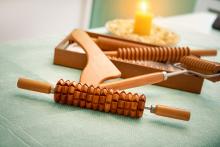
Massage therapy has powerful healing properties. There is simply nothing that compares to the warmth and precision of real human touch. But modern life has become so tense and stressful that an increasing number of clients are suffering from chronic tension: painful muscle spasms and conditions like fibromyalgia, where they feel a diffuse discomfort almost every day. Many people are suffering greatly and extremely few can afford therapy daily to get relief. That is why it’s important for massage therapists to educate clients and recommend powerful “adjunct therapies” that complement their massage services.
Here are 5 powerful tools every massage therapist or sufferer of chronic pain or physical tension should know about:
1. Acupressure Mats
Acupressure is a form of touch therapy that involves pressing on tiny meridian points to stimulate and relax the nervous system. It’s kind of like acupuncture, but without breaking the skin. Acupressure mats are made of fabric and covered with hundreds of tiny, sharp, short plastic spines. They are like a milder version of a “bed of nails” that you can stand or lie on. When you first lie on an acupressure mat, it hurts your back. But after several minutes the discomfort gives way to a tingling sensation and eventually physical and mental relaxation. A 20-minute session before bed helps some people with insomnia issues. You can also stand on it for vigorous foot stimulation.
2. Far Infrared Heating Mats
Far Infrared (FIR) is a part of the electromagnetic wave spectrum that has been investigated for its biological and therapeutic effects. Evidence suggests it may help emotional disorders. You can buy a number of electronic therapy mats that emit FIR waves through embedded stones such as jade or amethyst—like an advanced “microwave heating pad.” Lying on a FIR infrared mat feels like lying on warm beach sand, and some people claim that it calms anxiety almost instantly. Others say it relieves back pain or diffuse neurological discomfort like fibromyalgia. If used on very high settings or for extended periods of time, it causes some people to sweat and have a sauna-like “detox” experience. Get used to it gradually, starting with short 5-minute sessions.
3. Trigger Point Therapy Balls
A skilled massage therapist can perform miracles on muscle spasms and knots, but sometimes they are so severe and numerous that you just don’t have the hand strength or stamina to get them all out. Luckily for you and your patients, a trigger point therapy ball can do a lot of the “heavy lifting” at unraveling muscle tension by using the sufferer’s own body weight. “You can use a lacrosse ball, which is only five bucks, or a custom therapy ball and gently roll the body over it, staying on top of knots and tense areas for a minute or more until they fully release,” says Dr. Bomi Joseph of the Peak Health Center.
4. Trigger Point Massage Canes
Have you ever wished that you could give yourself a nice, firm backrub? With a trigger point massage cane, you can. And you can do it with great precision and almost as much pressure as you can tolerate. These curved, knobby plastic massage tools are extremely empowering to resourceful clients with chronic tension and spasms. They curve around behind your back and allow you leverage to access specific points that would otherwise be impossible to reach. It takes a bit of time to learn all the different angles and possibilities, but once you do, you will be happy you did. This is a tool that truly “has your back” and is there for you, whenever you need it.
5. Back & Body Rollers
Self-myofascial release, more commonly known as foam rolling, has been used by professional athletes and therapists for many years. A cylindrical foam roller can be slipped under the back, legs, or other tense body parts and slowly rolled up and down for potent, soothing relief. Foam rollers are good because they are soft on the bones in your back but still apply firm pressure to the muscle and soft tissues. There are also wooden and plastic rollers that cradle the sides of the spine. Because these are much harder in texture and produce more intense pressure and release, they should be used slowly and cautiously. The key thing to remember is to roll slowly, spending a minute or more in each spot before moving on.
These tools are versatile, powerful, and can make a huge difference in the lives of your clients. And while they do afford a degree of relief, the quality of touch they impart is a bit “mechanical” and a totally different experience than what is provided by a skilled massage therapist. Try them and let them help you do your part in making the world a happier, healthier, and freer place—one body at a time.




